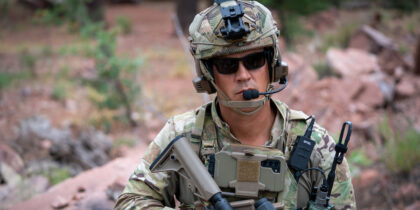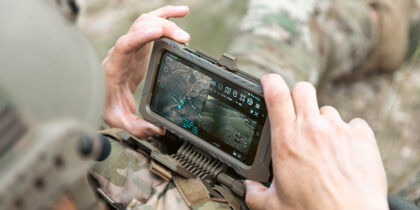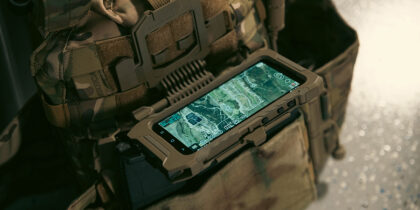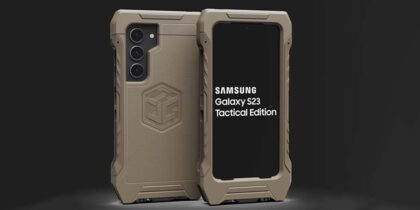Sign up to download the full white paper as a PDF.
Tactical teams and special operators face formidable challenges in an increasingly distributed battlefield — including complex terrain, long engagement ranges between troops, and loss of communication with Command. In environments where adversaries and operational environments evolve quickly and every second counts, military personnel success and survival require situational awareness during all phases of the mission.
As a result, operators are relying more and more on the power of mobility solutions to make informed decisions that impact mission success. Mobile technologies are transforming mission operations in the tactical environment by providing seamless communication capabilities for less cost with a bigger impact on the battlefield.
Mobility Is Transforming the Tactical Environment
Mobility solutions are enabling the personnel through ruggedized devices and custom software solutions that deliver communications, navigation, mapping, surveillance, reconnaissance, battlefield coordination, geospatial information and more. All these capabilities can now be securely accessed in the palm of a service members hand, integrated into the uniform, or mounted on equipment to help them make better decisions in theater, faster.
How the Military Is Deploying Mobile Solutions to Drive Mission Advantage
Mobile solutions will drive new levels of tactical agility as we enter a new era of warfare by making traditional tactical capabilities more flexible on a mobile platform. For service members specifically, mobile technologies will deliver enhanced situational awareness on distributed battlefields, enable greater coordination and serve as a force multiplier for command and control decisions.
Mobility Delivers Enhanced Situational Awareness
Mobility platforms are already making inroads at the Department of Defense (DoD), enabling service members to achieve greater situational awareness (SA) beyond line-of-sight, conduct Blue Force Tracking, and manage command and control (C2) and battlefield intelligence, as well as enhance surveillance and reconnaissance communications.
The United States Army’s PM Nett Warrior (NW) program is a leading example of how military leaders are adopting mobility to enhance such capabilities. NW aims to lower soldiers’ combat load, reduce the logistical footprint, avoid friendly fire and more effectively execute combat missions through secure army network communications. Specifically, NW’s optimized and integrated SA system capabilities connect dismounted leaders to the network through secure radio communications. Leaders can then pinpoint soldiers’ locations by accessing georeferenced mapping imagery through a mobile digital display.
As a result, the U.S. Army has been able to achieve quick mission command coordination between warfighting functions — from intelligence to maneuver, fire, sustainment or protection. According to Maj. Matthew Bailey, executive officer, 3rd Squadron, 2nd Cavalry Regiment, “With Nett Warrior, the ability to plan and rehearse an entire operation in a decentralized environment is unmatched. … We can have five troops spread across multiple areas of operation and never need to bring people together for a face-to-face meeting.”
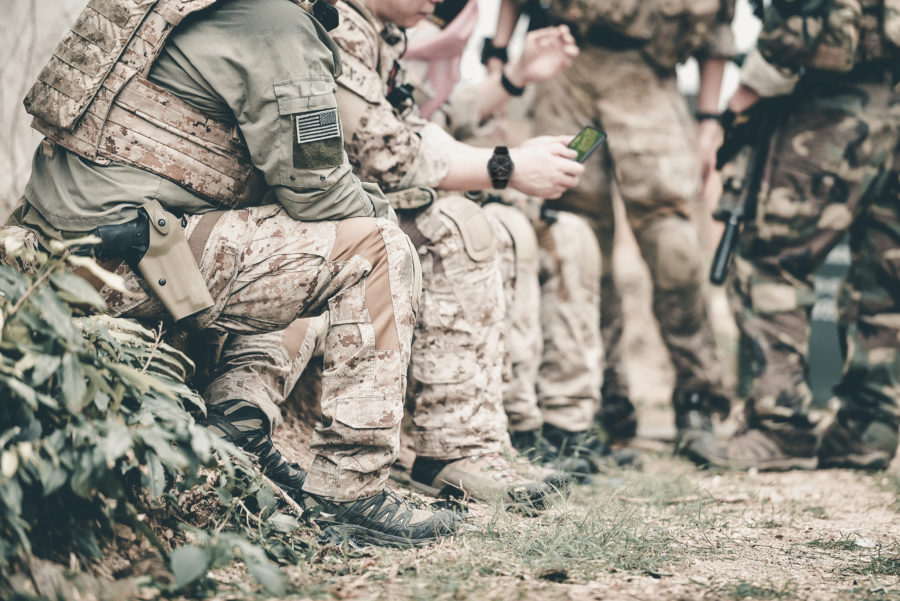
The Army is further developing the NW program by fielding a new mapping engine, the Android Tactical Assault Kit (ATAK). The geospatial infrastructure application was originally built using NASA World Wind Mobile and today overlays mapping, site survey, radio controls, web browsing, chat and more. ATAK’s single digital operational view delivers real-time SA, collaboration and C2 capabilities so service members better identify friendly troop locations to verify where to direct support.
ATAK is being used across military branches today. For example, in July 2018, the US Air Force’s (USAF) 96th Security Forces Squadron (SFS) began using ATAK in their patrol cars. Soon, the 96th SFS became the testing area for what could become a new Air Force-wide base defense communication platform. ATAK’s ability to deliver instant information is available to defenders on patrol, at an emergency or at the command and control hub, known as the base defense operations center (BDOC). ATAK works via cellular communication, GPS and a base network, managed by the Air Force Research-lab (AFRL), which acts as a hub linking the patrols and BDOC. Other non-ATAK functions, like vehicle and license check information, work virtually like a phone app. Word continues to spread across defense branches about ATAK’s dependability and ease of use.
Mobility Enables Greater Battlefield Coordination and Agility
Mobile device-based tactical applications can enable service members to act more quickly than ever before. For instance, they can help service members when calling in fire support that directly supports land, maritime, amphibious and special operations forces to engage enemy forces, combat formations and facilities in pursuit of tactical and operational objectives. DoD operations requires complex communication environments with service members often being separated by tens or even hundreds of miles and moving in three dimensions with unknown orientations. In such situations, radios and traditional devices can fail when losing network or signal.
Mobile platforms, however, can provide seamless communication even in such complex tactical environments, equipped with greater bandwidth and portability, regardless of whether service members are operating from land, sea or sky.
Transform Your Tactical Operations With Mobility
Sign up to download the full white paper as a PDF. Download Now
U.S. Marine Corps’ (USMC) Kinetic Integrated Low-cost Software Integrated Tactical Combat Handheld (KILSWITCH) is one example of such a battlefield solution. Designed to facilitate capabilities like real-time data sharing between both Joint Terminal Attack Controllers (JTACs) and overhead aircraft, forces can use KILSWITCH to quickly call in coordinates and confirm support. As a result of having quicker access to better information, troops have been able to use KILSWITCH to deliver strikes in four minutes, instead of what used to take half an hour to coordinate and execute.
According to the Office of Naval Research (ONR)’s Command Master Chief Matt Matteson, this capability can deliver clear battlefield advantage: “Because the KILSWITCH surface danger zone (SDZ) tool is handheld and portable, service members can plan live-fire training while in the field versus from inside of a command center. They’re able to walk the ground and see graphic representations of weaponry, which improves planning efficiency — especially when plans change suddenly.”
Similarly, the US Marine Corps (USMC) is using mission-purposed handheld tablets to support the Target Handoff System (THS), a configuration that determines a target’s location using embedded GPS technology and then digitally transmits the data to supporting arms elements. The THS automatically generates coordinates for supplied targets, then digitizes the data into a map on the smartphone to remove the need for manual output by a Marine.
The digital data is then transferred to the Fire Support Coordination Center, where they determine the proper approach of attack, so the mission can be quickly and effectively executed.
With GPS, real-time sharing and seamless communication capabilities, mobility can enable faster access to better information. Service members can then coordinate attacks more precisely, avoid enemy fire with more agility and more effectively achieve mission objectives.
Mobility as a Force Multiplier
DoD is currently looking at how mobile solutions can both better support troops in the field by empowering service members with access to tools that can make them more effective, as well as significantly improve safety by limiting the number of soldiers being put in harm’s way.
For example, the USMC recently announced that it is reducing the size of its rifle squads from 13 to 12 men while maintaining effectiveness with the addition of new capabilities and gear including tablets and drones. As part of this effort, USMC is focusing on SEA DRAGON — a live-force experiment campaign designed to assess changes that new technologies and tablets bring to the battlefield, like addressing the threat of unmanned aerial systems (UAS) and serving as a force multiplier.
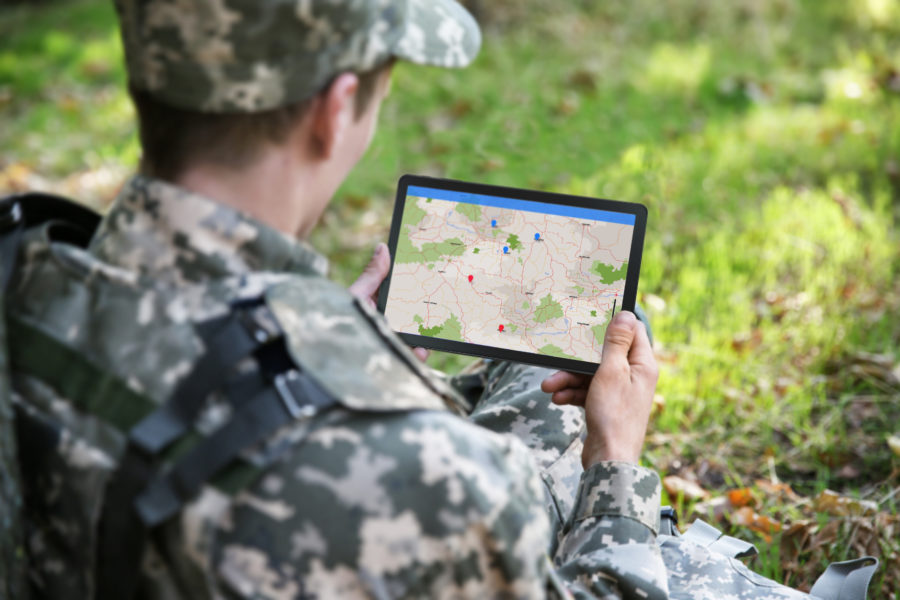
In an effort to increase the effectiveness of smaller forces, the Marine Corps Warfighting Lab successfully tested the ability to have a single Marine operate six drones in the air simultaneously from a single handheld tablet. The goal is to get the number up to 15 and see the small UAS stay in the air for longer periods of time. Capt. Matt Cornachio, a fires project officer with the Warfighting Lab’s science and technology division said, “We’re looking at having minimal operator burden. … It’s having the machines do the work for you, so you give them intent and they operate.”
Handheld devices as force multipliers can help troops in remote or hotly contested locations augment 60mm mortar fire with precision strikes. Overall, the Corps wants every rifle squad qualified to direct air, naval and artillery fire using these new mobile technologies, which enables them to take on added responsibilities — equipping even the smallest combat units to survive with better tools and trainings.
5G Will Transform Tactical Operations Across Smart Bases and Connected Commands
5G networks promise service members the ability to achieve anything on the battlefield, from any location. These capabilities are all accessible from the palm of their hands, including complex data analytics insights, enhanced battlefield command and control and new levels of combat preparedness — topped off with operational efficiencies and streamlined costs. There are already a number of exciting use cases for the military, ranging from increased supply chain visibility to improved human and mission performance and enhanced combat training — with additional capabilities rapidly evolving to meet tactical needs.
5G Networks Increase Supply Chain Visibility and Control
Defense agencies can use 5G to increase supply chain visibility for missions requiring real-time asset visibility, inventory tracking and warehouse management. With 5G, mobile devices can be turned into enterprise-grade barcode scanners that are already connected into logistics systems and databases for real-time visibility. Flight line operations and maintenance teams in USAF, for example, can leverage tablets within a secure 5G network environment to view real-time inventory and schematics, better use spare parts, manage aircraft diagnostics solutions and more. USAF can also advance projects around Electronic Flight Bags (EFBs) and Electronic Knee Boards (EKBs) to minimize or eliminate paper use in cockpits. The safety and cost benefits of these types of mobile solutions add up: “For every pound of weight removed from the aircraft, you save a certain amount of fuel on a given sortie. For instance, if you remove 120 pounds of paper from every single sortie, we calculated the command would save about $780,000 per year in fuel cost within the mobility air forces,” outlined Richard Quidgeon, AMC electronic flight bag requirements manager, in a 2017 release.
5G Networks Improve Human and Mission Performance
5G networks can enable real-time analytics and data collection through wearable sensors and technologies, ensuring soldiers can achieve peak health and performance on the battlefield. Recently, the Army doubled down on efforts to ensure service members are optimizing the performance triad (P3) of sleep, physical activity and nutrition — which ensures peak physical fitness, cognitive dominance, and emotional resilience. In conjunction with such efforts, the Army Research Institute of Environmental Medicine (USARIEM) strapped wearable sensors on soldiers from the 75th Ranger Regiment. The purpose of the study was to predict heat illness in soldiers and use real-time physiological status monitors, keeping track of soldiers’ core and skin temperatures as well as heart rates. This will help researchers see how the body responds when healthy and when experiencing heat illness or higher levels of stress.
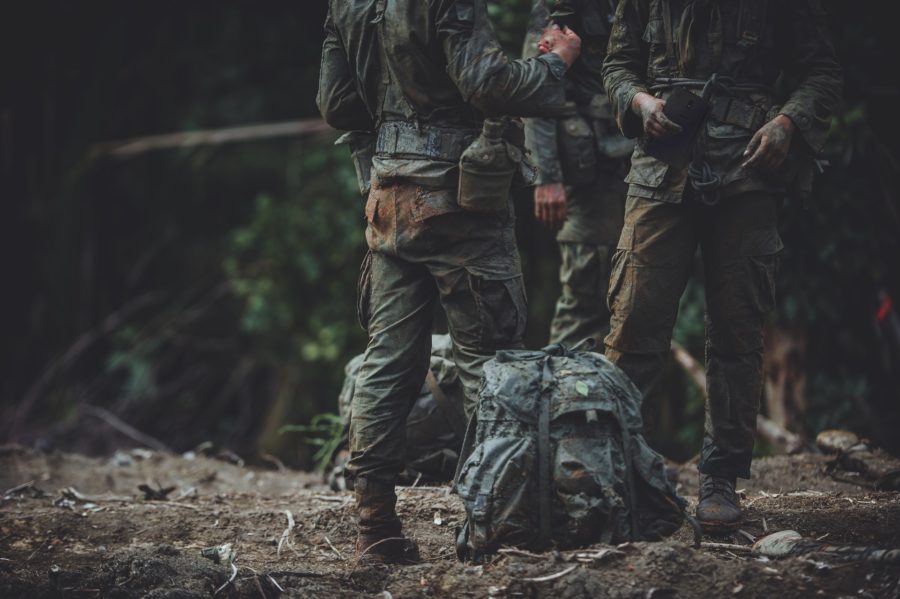
5G Networks Enable Higher Fidelity Immersive Training Technologies
DoD spends an estimated $14 billion or more per year on “synthetic” digital training that uses digital environments to teach and prepare personnel for real-life jobs and experiences as well as battlefield readiness. Rapid advancements like virtual reality (VR), augmented reality (AR) and mixed-reality (MR) technologies with 5G network connectivity will enable increasingly realistic, mobile-based simulations that help service members virtually navigate combat scenarios, maintenance crew learn repair techniques and medics treat patients in the field. This allows soldiers to minimize risk and wear and tear to equipment, and avoid the cost of putting a plane in the air, tank on the ground or ship in the sea.
Samsung’s Robust Mobile Ecosystem for Supporting Tactical Operations
Samsung’s mobile technologies powered by 5G networks deliver defense-grade security and are modernized, scalable and mission-ready for tactical environments. With these tactical technologies, service members can stay connected to their missions no matter where they are or what conditions they are in.
How Samsung Can Help Take Your Mission to the Edge
- COTS Mobility Solutions: By delivering an ecosystem of cost-effective and customizable consumer off the shelf (COTS) mobility solutions that are scalable and affordable, military operators can achieve advanced endpoint security without sacrificing high performance.
- Interoperability: Samsung’s tactical offering keeps the service members connected to the objective wherever the mission takes them, with a tailored software suite that integrates with common tactical radios and peripherals used in mission-critical environments.
- Defense-Grade Security: Knox is the mobile security platform chosen by agencies for classified use that secures devices down to the hardware, meeting and even exceeding the most stringent requirements for mission-critical environments. Certifications include CSfC, CC MDF PP, DoD APL, STIG FIPS 140-2 and IP68.
From DoD to federal law enforcement, leaders cannot afford to miss out on the new wave of mobile technologies that can transform critical tactical operations. Today’s service members require mission-ready mobile solutions that are operationally ready, interoperable, secure and proven — so communications are seamless and secure when it matters most.
Following are key solutions offered in the Samsung tactical suite:
- Galaxy S9 Tactical Edition (TE): A preconfigured software suite backed by defense-grade security that interoperates seamlessly with tactical radio systems and applications. TE is enabling the military to address emerging threats, modernize mission operations and reimagine what’s possible on the battlefield.
- Tab S3: Equipped with Samsung Knox for defense-grade security, this tablet has an additional layer of security with fingerprint authentication. Service members can leverage Knox with customizable services to build solutions tailored to specific tactical missions and objectives, giving IT administrators seamless manageability.
- Gear VR: Offers military personnel the opportunity to improve their skills and knowledge using inexpensive, untethered, fully mobile gear protected by military-grade security wherever they happen to be stationed. Users have access to on-demand training using headgear and sensors, enabling more participation and training to be delivered rapidly with 360-degree environments that provide combat experiences similar to live training but without the risk.
- HARMAN C2: Samsung’s HARMAN C2 solutions comprise audiovisual applications helping defense IT personnel and service members securely view and access critical data for the tactical mission, while validating its veracity. User-friendly interfaces make it easy for Command to focus on driving overarching mission outcomes while service members focus on the mission at hand.
- Samsung Knox: A defense-grade security platform that bakes in data protection down to the hardware, Knox provides granular access to device features, security options, customization settings and more. Knox provides over 2,000 APIs for key management and two separate libraries of FIPS 140-2 compliant cryptographic algorithms, making it easy for the military to secure and customize any device in the mobile ecosystem for tactical applications.
Technology serves more than ever as the front line of national security. Learn more about Samsung solutions for federal government and defense applications here.




